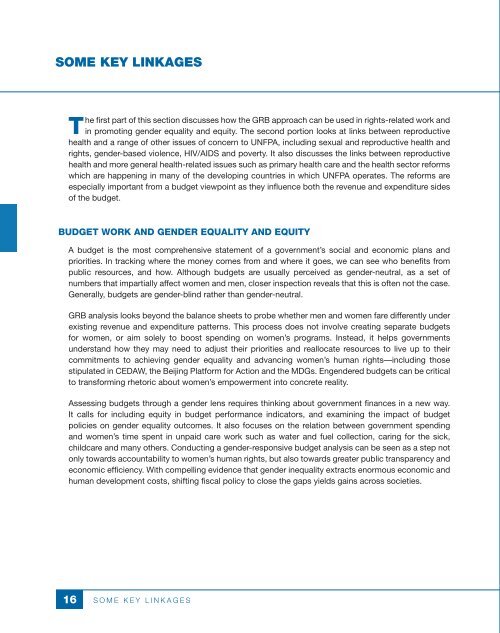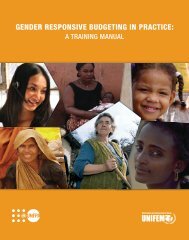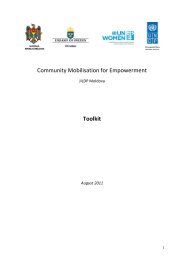Some key linkagesThe first part of this section discusses how the GRB approach can be used in rights-related work <strong>and</strong>in promoting gender equality <strong>and</strong> equity. The second portion looks at links between reproductivehealth <strong>and</strong> a range of other issues of concern to UNFPA, including sexual <strong>and</strong> reproductive health <strong>and</strong>rights, gender-based violence, HIV/AIDS <strong>and</strong> poverty. It also discusses the links between reproductivehealth <strong>and</strong> more general health-related issues such as primary health care <strong>and</strong> the health sector reformswhich are happening in many of the developing countries in which UNFPA operates. The reforms areespecially important from a budget viewpoint as they influence both the revenue <strong>and</strong> expenditure sidesof the budget.Budget work <strong>and</strong> gender equality <strong>and</strong> equityA budget is the most comprehensive statement of a government’s social <strong>and</strong> economic plans <strong>and</strong>priorities. In tracking where the money comes from <strong>and</strong> where it goes, we can see who benefits frompublic resources, <strong>and</strong> how. Although budgets are usually perceived as gender-neutral, as a set ofnumbers that impartially affect women <strong>and</strong> men, closer inspection reveals that this is often not the case.Generally, budgets are gender-blind rather than gender-neutral.GRB analysis looks beyond the balance sheets to probe whether men <strong>and</strong> women fare differently underexisting revenue <strong>and</strong> expenditure patterns. This process does not involve creating separate budgetsfor women, or aim solely to boost spending on women’s programs. Instead, it helps governmentsunderst<strong>and</strong> how they may need to adjust their priorities <strong>and</strong> reallocate resources to live up to theircommitments to achieving gender equality <strong>and</strong> advancing women’s human rights—including thosestipulated in CEDAW, the Beijing Platform for Action <strong>and</strong> the MDGs. Engendered budgets can be criticalto transforming rhetoric about women’s empowerment into concrete reality.Assessing budgets through a gender lens requires thinking about government finances in a new way.It calls for including equity in budget performance indicators, <strong>and</strong> examining the impact of budgetpolicies on gender equality outcomes. It also focuses on the relation between government spending<strong>and</strong> women’s time spent in unpaid care work such as water <strong>and</strong> fuel collection, caring for the sick,childcare <strong>and</strong> many others. Conducting a gender-responsive budget analysis can be seen as a step notonly towards accountability to women’s human rights, but also towards greater public transparency <strong>and</strong>economic efficiency. With compelling evidence that gender inequality extracts enormous economic <strong>and</strong>human development costs, shifting fiscal policy to close the gaps yields gains across societies.16S O M E K E Y L I N K A G E S
Box 2: Highlights of UNIFEM’s work in GRBWorking in close partnership with women’s organisations <strong>and</strong> scholars, UNIFEM has helped pioneer cutting-edge work on GRB that is being picked up byboth local <strong>and</strong> national governments. Advocacy <strong>and</strong> training for government officials, parliamentarians <strong>and</strong> women’s groups, the development of budgetanalysis tools <strong>and</strong> wide sharing of knowledge on what works have helped the concept catch on, resulting in changes in a number of countries.In Ecuador: After initial training sessions for local officials <strong>and</strong> women’s organisations, GRB work has taken off in a number of municipalities. InCuenca, local authorities issued a decree that makes it a priority to hire women for infrastructure projects. The city’s budget for the past three yearshas included specific funds to foster women’s equality, as spelled out in an Equal Opportunity Plan. Significant resources have been allocated to backa law entitling pregnant women <strong>and</strong> newborn babies to free medical care, <strong>and</strong> the government has joined local women’s groups on programs to curbviolence against women. Another municipality, Esmeraldas, has set up a fund for local women’s micro-enterprises <strong>and</strong> created an Equity Council toadvise on <strong>and</strong> monitor municipal gender policies. Salitre has allocated more resources to women’s organisations. Quito has established a Secretariatfor <strong>Gender</strong> <strong>and</strong> Social Equity.In Bolivia: After an advocacy campaign coordinated by the Instituto de Formacion Femenina Integral of Cochabamba with the support of UNIFEM, theMinistry of Finance included in the Guidelines for the Elaboration of the Annual Operational Plans of Municipalities an obligation to allocate resources forprograms <strong>and</strong> projects aimed at achieving gender equity. The guidelines also stated that municipalities must specify who is responsible for the differentgender equity activities.In India: Several years of sustained advocacy <strong>and</strong> partnerships between the Department of Women <strong>and</strong> Children, UNIFEM <strong>and</strong> women’s organisationshave encouraged the national government to affirm the importance of gender budgeting. This was initially done through the inclusion of a genderbudget statement in the 2003 Union Budget <strong>and</strong> through official studies of the issue. In 2005, the Finance Minister committed to moving forward onimplementation. Twenty-one national ministries have now set up gender-budgeting cells. For the fiscal year 2005–2006, 18 departments are rolling outdetailed specifications of allocations <strong>and</strong> targets benefiting women. At the state level, in West Bengal, UNIFEM supported the organisation Sachetana toprepare a gender budgeting manual that the group has used to train over 1,000 women councillors in local governments. In Karnataka, another state,elected women representatives in the city of Mysore used gender budgeting to prevent a proposed budget cut targeting women’s programs. They endedup securing a 56% increase in funding instead, <strong>and</strong> started advocacy for more transparent public information in the future.In Mexico: Extensive mobilisation of women’s groups, spearheaded by UNIFEM partners, persuaded the government in 2003 to earmark 0.85% ofthe total national budget for programs to promote gender equality. Since then, 14 ministries have been required to report quarterly on these programs.In the states of Morelos, Queretaro <strong>and</strong> Chiapas, the Ministry of Health has used a guide for integrating gender issues in health budgets—producedby the national health ministry with UNIFEM assistance—to improve the health services it offers to women <strong>and</strong> to channel more resources into priorityhealth needs.In Brazil: UNIFEM has carried out a range of activities, including offering courses on gender <strong>and</strong> macroeconomic policy to senior policy makers,helping to establish links between GRB advocates <strong>and</strong> parliamentarians, <strong>and</strong> sponsoring a well-respected NGO to conduct a four-year gender review oflegislative policies <strong>and</strong> budget allocations. The national government has carried out a preliminary gender analysis of the federal multi-year plan that willassist them in ensuring that the national budget incorporates gender-sensitive planning <strong>and</strong> allocations. The government has already used similar toolsto tailor services described in the National Health Plan to the needs of different racial groups. Through an advocacy campaign, the Centro Feminista deEstudios y Servicios de Asesoría achieved the inclusion of key programs for gender equality <strong>and</strong> women’s rights in the expenditure monitoring systemSIGA-BRASIL. This program is an initiative of the Brazilian Federal Senate to create a public information system (available through their website) thatallows any person to access databases on planning <strong>and</strong> budgeting information.In the Philippines: GRB started in 1995, with a <strong>Gender</strong> <strong>and</strong> Development (GAD) budget policy that stated that government agencies must allocate5% of their budget for activities related to gender <strong>and</strong> development. More recently, UNIFEM has supported the national women’s machinery, the NationalCommission on the Role of Filipino Women, to intervene in the budget reform process which aims to transform the budgeting process from line item toperformance-based budgeting. The aim of the intervention is to create tools to institutionalise gender-responsiveness in the process. At the local level,an NGO has assisted local communities to work with local government units in the preparation of local budgets that are gender-responsive.S O M E K E Y L I N K A G E S17





